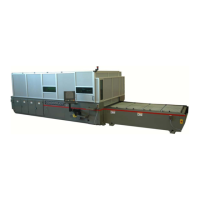3-3
EM-573 (N-04-18)
Governmental Industrial Hygienists (ACGIH). Internationally, the World Health Organization (WHO) has laser
safety guidelines, and the International Electrotechnical Commission (IEC) has been developing laser safety
standards.
In 1968, the U.S. Government passed a law regulating products used in the United States that radiate energy.
The law is the “Radiation Control for Health and Safety Act of 1968”. This law sets standards of performance for
electrical products that emit radiation.
Laws like these are called U. S. Federal Laser Product Performance Standards or FLPPS. Manufacturers use
FLPPS to ensure the design and manufacture of their product properly controls radiation hazards before the
product is released to their customers. Examples of some of the products covered under this law are x-ray
machines, microwave ovens, hair dryers, and all types of lasers.
The Federal Standards covering Lasers and Laser Products (for example, devices or machines containing a
laser) are covered in the Federal Register at 21 CFR Part 1040.
Based on these standards, the level of radiation accessible to persons is used to group lasers into one of four
classes. The classes are Class I, Class I.A., Class II, and Class IIIA., and Class IIIB, Class IV. These classes or
risk categories establish the hazard controls required in the product’s design before a manufacturer can turn a
product over to a user.
Research studies, along with an understanding of the hazards of sunlight and conventional, man-made light
sources have permitted scientists to establish safe exposure limits for nearly all types of laser radiation. Laser
safety specialists call these limits Maximum Permissible Exposures (MPE’s).
The standards and publications listed below will be the most helpful to users of CINCINNATI Laser Systems:
1. ANSI B11.21 “American National Standard for Machines Using Lasers”. The contents of this standard
came from the users and manufacturers of the machines that use laser generated
beams to process material.
2. ANSI Z136.1 “American National Standard for Safe Use of Lasers”. This standard, which is technical
in content, was developed by the research and health community to cover all types of
lasers and laser applications.
3. OSHA
Publication 8-1.7
“Guidelines for Laser Safety and Hazard Assessment”. This was developed for OSHA
eld personnel to help in their job of enforcing workplace safety standards.
LASER HAZARD CLASSIFICATION
Virtually all of the U.S. domestic as well as all international standards divide lasers into six major hazard
categories called the laser hazard classications. The classes are based upon a scheme of graded risk. They
are based upon the ability of a beam to cause biological damage to the eye or skin. In the FLPPS, the classes
are established relative to the Accessible Emission Limits (AEL) provided in tables in the standard. In the ANSI
Z 136.1 standard, the AEL is dened as the product of the Maximum Permissible Exposure (MPE) level and the
area of the limiting aperture. For visible and near infrared lasers, the limiting aperture is based upon the “worst-
case” pupil opening and is a 7 mm circular opening.
Lasers and laser systems are assigned one of six broad Classes (I to IV) depending on the potential for causing
biological damage. The biological basis of the hazard classes are summarized in the table below.
Class I: Cannot emit laser radiation at known hazard levels (typically continuous wave: cw 0.4 μW at
visible wavelengths). Users of Class I laser products are generally exempt from radiation hazard
controls during operation and maintenance (but not necessarily during service).

